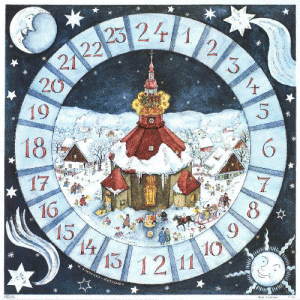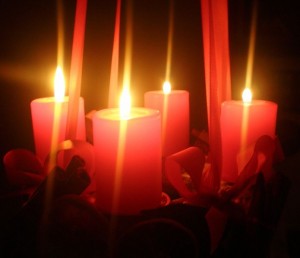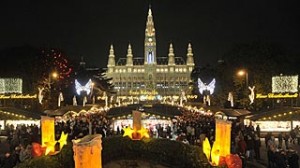Advent in Vienna – Then and Now

The quietest time of the year?
It’s already beginning again: Advent, the quietest and most contemplative time of the year…. At least that’s what it once was: Today, you sometimes encounter the chocolate Krampuses and Christmas gingerbread cakes as early as September, and the shops are illuminated with Christmas decorations and lights at the end of October at the latest. While we still look forward to Christmas, Advent is generally mostly marked by hustle and bustle and the rush of shoppers. Only seldom is it quiet and contemplative.
Advent as a time of penitence and fasting
Yes, you read that correctly. Already since the 5th century, Advent was considered, according to Christian understanding, a time of fasting and preparation for the celebration of the birth of Jesus Christ. Inner change, contemplation and penitence accompanied this period. Since Pope Gregory I, also called Gregory the Great, Advent as a preparatory period for Christmas has also been considered a family celebration (as well as children’s favorite celebration).
Advent has always begun on the first Sunday after November 26 – this first Advent Sunday also happens to be the beginning of the church year. During the Advent period, priests wear violet tunicles at mass – violet symbolizes change and is therefore the color of Advent and the Lenten season. Moreover, while mass is celebrated during Advent, the “Gloria” is omitted, likewise a sign of contemplation. The four Advent Sundays in the church are composed as follows:
1st Advent Sunday: Texts are marked by the Parousia (return or second coming) of Christ.
2nd and 3rd Advent Sundays: The figure of John the Baptist is the focus.
4th Advent Sunday: dedicated to Mary, the mother of God.
Advent customs – then and now
The Advent calendar
What would Advent be without the Advent calendar? Whether it’s printed with beautiful picture, filled with chocolate or little toys – it shortens the wait for the Christ child. The actual origins of Advent can be traced back to the 19th century. The first self-made Advent calendar is presumably from the year 1851. Either 24 religious images were hung on the wall one by one or 24 chalk marks were made that were wiped away every day, or straw was laid in a manger every day. Christmas clocks or Advent candles were additional early variants. In 1902, the Protestant Bookshop in Hamburg (Evangelische Buchhandlung) published the first printed calendar. In 1903, the Munich-based publisher Gerhard Lang launched a calendar with the title “In the Country of the Christ Child.” It consisted of an arc with 24 images for cutting out and an arc with 24 fields for pasting. Lang soon also introduced a type of chocolate Advent calendar, the “Little Christ Child’s House,” for filling with chocolate. Ultimately, after 1920, calendars with windows that could be opened gained popularity.
During the National Socialist era, pre-Christmas calendars, with winter solstice beneath the swastika, became the focus rather than Christmas night.
The Advent calendar started becoming popular in the 1950s, when it became a mass-produced good and accordingly low-priced. Behind the larger window of December 24, a nativity scene usually lay hidden. Behind the chocolate lay hidden an image with a motive from the history of Christmas, which preserved the connection to Christmastime. Today, behind the 24 little doors of a typical purchased product are often pieces of chocolate in various “Christmassy” shapes or a toy.
Since Advent calendars are now marketed worldwide, the motives need to be understood everywhere. Instead of Mary and Joseph, we now also have bears or Bambi. Advent calendars with alcohol-free pralines and Islamic themes are also sold. Advent calendars on the internet are often more directed at an adult target audience or supplied with daily offers. In numerous cities, the facades of certain buildings, often of town halls, are repurposed into giant Advent calendars. A famous example of this is the Vienna City Hall, in front of which the Vienna Christmas market (Christkindlmarkt) takes place.
The Advent wreath
The Advent wreath has a relatively young tradition. Since approximately 1860, the Advent wreath has been made of fir-tree sprigs and fitted with four candles. This classic variant nowadays developed from the so-called Wichern Advent wreath with 18 or 24 candles, created in 1839. In 1925, an Advent wreath was hung in a Catholic church for the first time, in Cologne, Germany. The first Advent wreath in Munich followed in 1930.
In Austria, the Advent wreath has been well-known since the 1940s. In the Catholic church, Advent wreaths have three violet candles and one pink candle, which is meant for the third Advent Sunday. Every Sunday, one additional candle is lighted. Anyone who sits around the lighted Advent wreath with his or her loved ones still feels the contemplativeness and the eager anticipation of Christmas.
St. Barbara and “Barbarazweige”
Saint Barbara and her “Barbarazweige” (“Barbara branches”) are nowadays known almost exclusively in rural areas, and there are almost as many meanings as there are areas that observe the “Barbarazweige” tradition. According to the old tradition, on December 4, St. Barbara’s Day, one removes a branch from a cherry tree and places it in water in the hopes that it will bloom on Christmas Day. The blooming of the branch brings all household members happiness or announces a marriage. The Christmas carol “A Rose Has Sprung” hearkens back to this symbolism.
Krampus & St. Nicholas
Inextricably linked to Advent is also “Krampus & St. Nicholas.” In some rural areas even to the present day, on the evening of December 5, “Kramperln” (little Krampuses – creatures from Alpine folklore who punish children who misbehave) run around town and clatter on the doors with their chains. In contrast, you can look forward to December 6, when St. Nicholas makes the rounds with small gifts – always accompanied by Krampus just in case someone wasn’t a good boy or girl. Already since the 16th century, the two have been traveling together, Krampus punitive and St. Nicholas praising. The word “Krampus” is the Viennese version of “devil” and comes from “Krampen,” which means “claw.” The frightening figure next to St. Nicholas is supposed to punish naughty children. Today, Krampus – probably for pedagogical reasons – hardly appears anymore; aside from clattering on the door with his chain, we don’t hear much of him. He has become a minor character to St. Nicholas.
And lots more…
What else is definitely part of Advent? For me at any rate, it’s baking Christmas cookies, occasionally singing Christmas carols, selecting and potentially acquiring new Christmas ornaments, procuring Christmas presents and – not to be forgotten – visiting the various Christmas markets in Vienna, which incidentally are also able to look back on a long tradition. Already in 1382 there was the “Katharinenmarkt,” which began on December 25 and lasted four weeks. The market on the Freyung has existed since 1772, and the Christmas stands also moved to the square Am Hof starting in 1823. As of 1923, the places have changed more frequently, up until the City Hall Square was set up as a provisional market in 1975 – and it remains to this day as the largest Christmas market in Vienna. A mug of punch or mulled wine to warm you up and a paper bag with tasty roasted chestnuts are musts. Today, a multitude of Christmas markets can be found in Vienna, and every one of them is easily reachable on foot or via public transportation from the Schick Hotels Vienna.
I already wish you a lovely and contemplative Advent!
Photo credits © www.wien.info , www.wien.gv.at











